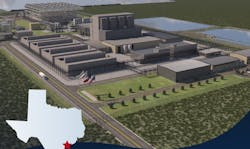NRC Reviewing Nuclear SMR Permit to Power Dow Chemical Manufacturing on Gulf Coast
The U.S. Nuclear Regulatory Commission has accepted and will review a construction permit application for building an X-energy 320-MW small modular reactor nuclear plant to power Dow Chemical’s 4,200-acre manufacturing complex on the Texas Gulf Coast.
The NRC will review the construction permit application from Long Mott Energy LLC, a subsidiary of Dow Chemical. The companies want to build a new multi-unit SMR nuclear plant to directly power Dow’s Seadrift operation, which manufactures more than 4 billion pounds of materials annually, including materials for footwear, solar cell membranes, wire and cable insulation, food and medical packaging.
Dow previously noted that construction on the Long Mott Generating Station could begin as early as 2026, according to earlier reports. The SMR power plant would employ four X-energy Xe-100 high-temperature, gas-cooled reactors with 80 MW of capacity each.
Whether the 2026 timeline is still viable is unknown. NRC has not announced a deadline for its own safety review and decision on the project.
Dow’s Seadrift operations (SDO), which is run by the company’s Union Carbide subsidiary, is currently powered by fossil-fuel generation. Utilizing carbon-free nuclear power could cut Seadrift’s greenhouse gas emissions by about 440,000 metric tons of carbon dioxide equivalent per year, according to estimates.
“The operation of SDO requires a combination of electrical power and high-temperature steam with high reliability and capacity factors,” reads the introduction to the environmental portion of Dow and Long Mott’s construction permit application to the NRC. “SDO currently relies on an adjacent natural gas fired cogeneration plant with gas turbines and heat recovery steam generators for that purpose. However, the existing cogeneration plant is reaching the end of its operating life.”
Dow and X-energy first announced their partnership in early 2023 to showcase a future grid-scale next-generation nuclear reactor for an industrial site in North America. The announcement came after the U.S. Department of Energy (DOE) made Dow a sub-awardee under X-energy’s Advanced Reactor Demonstration Program (ARDP) Cooperative Agreement.
X-energy previously has contracted with several companies to help build the Xe-100 SMRs, including engineering, procurement and construction firms. Those EPC firms include Day & Zimmerman, Burns & McDonnell and Zachry Group.
“The purpose of and need for the proposed action is to demonstrate the Xe-100 advanced reactor in support of )the DOE ‘s ARDP) and to replace the existing natural gas-fired cogeneration plant at the SDO site with a non-carbon emitting generating plant (consistent with Dow's corporate decarbonization goals) that meets Texas regulatory requirements and is capable of producing approximately 320 megawatt electric (MWe) of power or 800 megawatt thermal (MWt) of steam with high reliability and a high-capacity factor with intra-hour flexibility,” reads the Dow-Long Mott permit application to the NRC.
Dow is not alone in seeking carbon-free advanced nuclear to power future industrial efforts. Data and tech firms such as Google and Microsoft are partnering with SMR and conventional nuclear generators to help meet future data center load that was unforeseen by grid planners only a few years ago.
Google recently announced a contract with Elementl Power to find and secure advanced nuclear reactor sites to power artificial intelligence data center sites.
Each of the four 80-MW X-energy reactors would use helium to cool the core, according to the NRC report. Even if the commission should approve the permit application for construction, the companies would be required to gain another round of operational approval before commissioning.
Many decarbonization advocates are supportive of utilizing future small nuclear power as flexible and baseload power generation. Some opponents, however, criticize the projects as too costly and potentially hazardous compared to solar, wind and even gas-fired turbines.
No SMR facilities are built or even approved for construction in the U.S. yet. Canada’s Ontario Power Generation recently gained the approval to build a next-gen small reactor project at its Darlington site and expects to complete that by the end of the decade.
X-energy has received financial support from many investors, including Amazon’s Climate Pledge Fund, an affiliate of the University of Michigan and Ares Management Funds. The company recently closed on a $700 million C-1 financing round.
About the Author
Rod Walton, EnergyTech Managing Editor
Managing Editor
For EnergyTech editorial inquiries, please contact Managing Editor Rod Walton at [email protected].
Rod Walton has spent 17 years covering the energy industry as a newspaper and trade journalist. He formerly was energy writer and business editor at the Tulsa World. Later, he spent six years covering the electricity power sector for Pennwell and Clarion Events. He joined Endeavor and EnergyTech in November 2021.
Walton earned his Bachelors degree in journalism from the University of Oklahoma. His career stops include the Moore American, Bartlesville Examiner-Enterprise, Wagoner Tribune and Tulsa World.
EnergyTech is focused on the mission critical and large-scale energy users and their sustainability and resiliency goals. These include the commercial and industrial sectors, as well as the military, universities, data centers and microgrids. The C&I sectors together account for close to 30 percent of greenhouse gas emissions in the U.S.
He was named Managing Editor for Microgrid Knowledge and EnergyTech starting July 1, 2023
Many large-scale energy users such as Fortune 500 companies, and mission-critical users such as military bases, universities, healthcare facilities, public safety and data centers, shifting their energy priorities to reach net-zero carbon goals within the coming decades. These include plans for renewable energy power purchase agreements, but also on-site resiliency projects such as microgrids, combined heat and power, rooftop solar, energy storage, digitalization and building efficiency upgrades.


